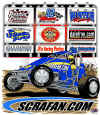


|
Traditional Sprint Car FanSite |
See You At The Races!!! |
| MAKING
THE SWITCH: WHAT DOES IT TAKE TO CHANGE A SPRINT CAR FROM DIRT TO
ASPHALT ? by Debbie Shipherd |
|
|
|
The traveling NCMA sprint club is unique as it
is the only wingless carbureted sprint group to race on both dirt
and asphalt tracks. Here is a brief explanation of what it takes to
change, following the club's rules. These are the basic, and least
costly ways to convert. There are other things allowed to change a
car, but then one must follow pavement chassis rules. Please note
that club drivers and crews will help interested drivers with
pavement tire loans, advice for converting, as well as basic set up.
Also, the later additions of Sprint Car Chassis Technology
by Steve Smith and Jimmy Sills have sections on pavement racing,
which can be very helpful. B. ADDITIONAL NORMAL CHANGES MOST MAKE |
